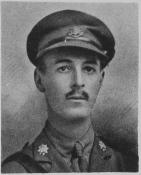
|
The King's School Canterbury |
Roll of Honour |
| Captain Lawrence Henry JONES | |
|
2nd Battalion East Surrey Regiment attached to the 1st Battalion Date of birth: 14th March 1892 Date of death: 5th October 1917 Killed in action aged 25 Buried at Hooge Crater Cemetery Plot XI Row H Grave 10 |

|
| He was born at Forest Hill, Kent on the 14th of March 1892 the second son of Canon Gustavus John Jones, Rector of Crayford, and Ethel Annie (nee Angus) of The Rectory, Crayford in Kent. He was educated at the King's School Canterbury from September 1901 to April 1908. On leaving school he was employed as a grain trader with W.H. Muller and Co of Bury Street, London, a member of the Baltic Exchange. Following the outbreak of war he enlisted at Duke's Road, Euston Road as Private 1726 in the 1/28th (County of London) Battalion (Artists Rifles) on the 8th of August 1914. At a medical examination, which took place on the same day, it was recorded that he was six feet one inch tall. He volunteered for overseas service on the 23rd of October 1914 and embarked for France with his battalion at Southampton on the 26th of October and landed in France the following day. The battalion became an Officers Training Corps situated at Bailleul. He returned to England for officer training on the 13th of November 1914 and he was commissioned as a 2nd Lieutenant into the 2nd Battalion East Surrey Regiment on the 9th of May 1915. He was posted to the 2nd Battalion East Surrey Regiment and immediately saw action at the Second Battle of Ypres when he was gassed on the 24th of May 1915 during a German attack at Potijze. He was evacuated back to England from Boulogne on the 26th of May on board the Hospital Ship "St David" and landed at Dover later the same day. He was admitted to Lady Evelyn Mason's Hospital at 16 Bolton Street on the 27th of May. A Medical Board sat at Caxton Hall on the 3rd of June 1915 to consider his case: - "This officer was in the trenches when poisonous gas was used by the enemy. He had a respirator which acted well for a time, but he was soon overcome: coughed a great deal, eyes watery and painful, very weak for days afterwards. Still complains of debility and attacks of giddiness." Although a Medical Board, which sat at the Military Hospital, Devonport on the 4th of November 1914, declared him as fit for general service he remained in England until April 1917. When he returned to the front that month he was attached to the 1st Battalion of his regiment. He was promoted to Acting Captain on the 20th of July 1917. He was home on leave in September 1917. The morning of the 4th of October 1917 was dull with slight rain. At 6am the 1st Battalion East Surreys were in close support of a battalion of the Duke of Cornwall's Light Infantry for an attack on Juniper Hill, which fell in the first rush. They then attempted to take the German positions at Polderhoek Chateau but despite passing it on both sides they were unable to take the building itself due to a nest of machine guns which took the attacking troops in the rear. The Germans then threw eight attacks between the Menin Road and Reutal which pushed the Surreys and the Cornwall's back, with heavy casualties both from rifle and machine gun fire as well as artillery fire. On the 5th of October, the battalion were consolidating a new line to protect their flank following the attack the day before. When this was completed they were to hand over to a battalion of the Cheshire Regiment. During the handover (in the dark) the men naturally bunched up keep in touch with each other and it was at this time that there was a sudden 'strafe' after which Captain Jones was "reported missing believed killed" in the battalion war diary. The battalion history describes Captain Jones as an 'excellent officer'. An eyewitness statement was taken from Private 28592 R. Graham: - "About 8am on 4.10.17 I saw Capt. Jones lying near a pill box which was used as Coy. HQ before the advance. I have no doubt he was dead as I particularly looked for his injuries, and, being unable to find a wound, I am of the opinion that he died of shock." His Commanding Officer wrote:- "He was a very fine soldier, always showed the greatest coolness in action, and always set a high example of devotion to duty." His Chaplain wrote:- "He had made for himself a great position in the battalion, and his fellow officers always spoke of him with unqualified admiration and affection." The war diary and regimental history differ from the Commonwealth War Graves Commission on his date of death. He is commemorated on the war memorial at Crayford and on a plaque inside St Paulinus Church, Crayford and is remembered on his father's grave in the churchyard. |
|
Back